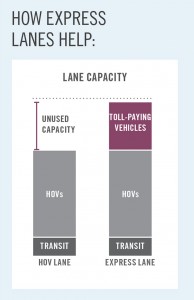The Ingenuity of Express Lanes
Being a San Francisco Bay Area native, I have witnessed the horrific automobile traffic problems in California for almost two decades. Especially during morning and afternoon rush hour commutes, cars heading towards the Silicon Valley, San Francisco, and Oakland are sometimes on a standstill for over two hours. From a network perspective, Bay Area traffic is a classic Nash Equilibrium problem that costs commuters millions of dollars each year.
California took the first step to solve this problem in April 1970, with the idea of the carpool (HOV) lane. The carpool lane is a restricted traffic lane, usually during rush hours, that only allows cars holding two or more passengers to travel on. Urban planners believed that the carpool lane would increase the average vehicle occupancy, thus reducing the amount of cars on the road. However, when two California researchers Kwon Jaimyoung and Prayin Varaiya decided to complete a study of HOV in the San Francisco Bay Area, they realized that these restricted lanes do not actually reduce traffic times by decreasing the amount of cars in the road. Instead, these lanes increase the volume of traffic in the regular lanes, essentially taking away one freeway lane during rush hours. Luckily, the Metropolitan Transportation Commission is working on a solution called the Express Lane. Here’s how it works.
Bay Area Express Lanes are converted carpool lanes that carry carpoolers as well as riders who wish to pay an electronic toll. The price of this toll varies depending on the amount of traffic on the freeway, thus accommodating all riders instead of only carpoolers. These express lanes successfully fill lane capacity, thus reaching an equal balance on all lanes of the freeway. For many riders, especially in the San Francisco Bay Area, time is money. This Nash Equilibrium can be thought of in the variable of money, and not time. If every minute stuck in traffic is worth $1, and a rider could save 20 minutes by paying $5, the rider would most likely pay the fare for financial reasons alone. Riders would keep paying the toll until Nash Equilibrium is reached (where there is no monetary incentive to switch to either lane). From an economist’s point of view, many commuters would rather pay an electronic toll in order to save time in a traffic jam, because they would still be reaping economic profit from doing so.
Citations:
http://bayareaexpresslanes.org/benefits/
http://www20.csueastbay.edu/news/2013/11/edmontonsun-ProfKwonJaimyoung-103013.html

